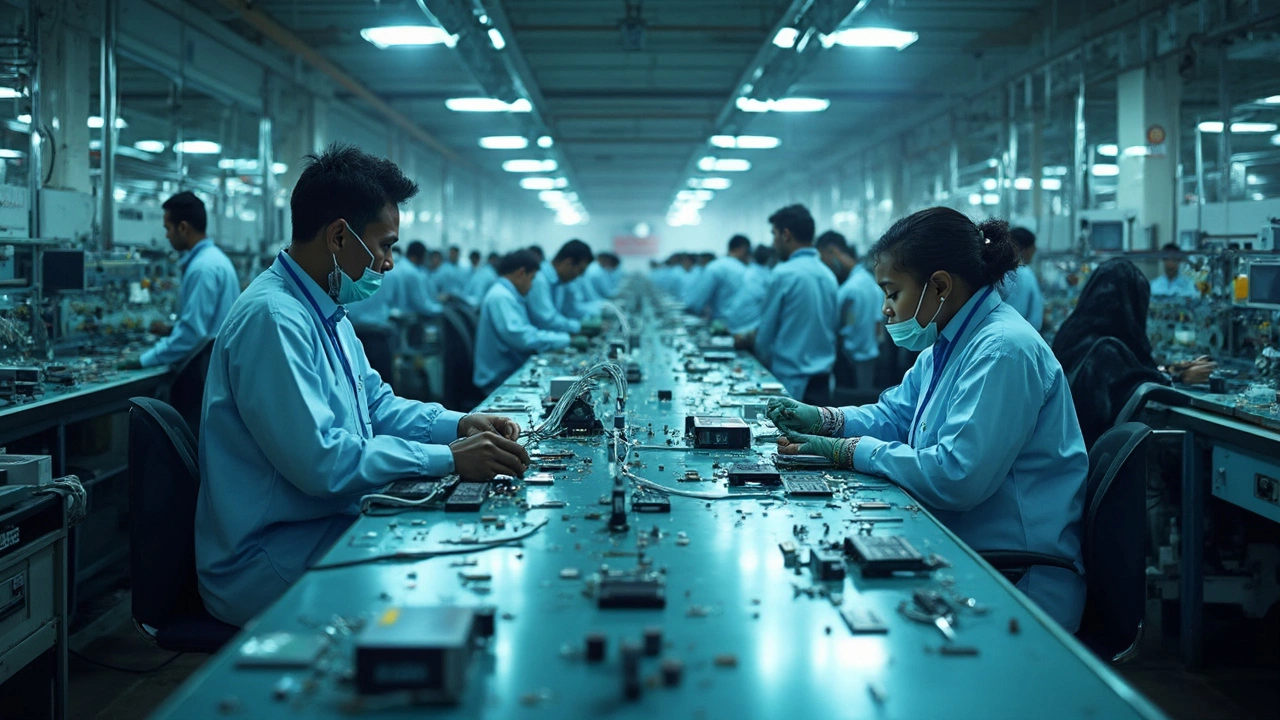So, why hasn't India managed to become that go-to place for electronics manufacturing yet? It's a puzzle when you consider its huge talent pool and the growing market demand. But, like any big picture, there are pieces that don't quite fit.
Let's talk about infrastructure. It's kind of like having a Ferrari but with roads full of potholes—what's the point, right? India's infrastructure hasn't caught up with the needs of manufacturers. Power supply issues, inadequate roads, and ports that just aren't up to speed hinder efficiency.
Infrastructure Roadblocks
Ever wonder why India's not taking the crown in electronics manufacturing? Well, infrastructure is playing a big part in that story. It might sound boring, but it's actually kind of fascinating when you scratch the surface.
First off, there's the power supply situation. Having reliable electricity isn't just about keeping the lights on; it's crucial for operating machinery 24/7. Frequent outages and inconsistent power quality can result in downtime and damages, and that's a nightmare for any manufacturer.
Roads and transport are another major hiccup. Transporting raw materials and finished products becomes a hassle if the roads are more like obstacle courses. Not to mention, most ports that haven't been modernized struggle with handling the massive throughput needed for such a high-demand industry.
Logistics and Connectivity
Logistics, like all things, is all about staying connected. While India has numerous ports, the logistics network has room for improvement. Efficient connectivity from factories to ports is vital, but it's not always smooth sailing in India.
Industries are majorly set up in certain clusters, that's true, but without the backing of a seamless logistics network, time frames get stretched. Precious time. Time is money here, literally.
Telecommunications Network
Then begs the question, what about the digital side of things? A robust telecommunications network is necessary for modern manufacturing. It's all about automation and smart factories nowadays, and for that, you need strong internet connectivity and infrastructure.
So there you have it—some of the key roadblocks holding India back from becoming a leading hub in electronics manufacturing. With the right focus and investment on these roadblocks, the path could be smoothed out significantly. Until then, the race continues.
Regulatory Maze
Diving into India's regulatory maze can feel like navigating a never-ending labyrinth. There’s no denying that the country has some complex laws when it comes to getting into electronics manufacturing. One major hurdle is the inconsistent application of regulations between different states. It’s like a cricket match but with each state playing its own set of rules.
Take the electronics sector for example. Multiple approvals are needed, and anyone who's ever set up a company knows how bogged down this can get. Businesses have to pull strings across various departments, which takes time and patience—two things most startups are short of.
Complicated Tax Structure
The complex tax system also puts off businesses. Although GST (Goods and Services Tax) was meant to simplify taxes, the rates, rules, and filing requirements are still not straightforward for many companies. SMEs find the compliance aspect overwhelming, taking away focus from their business operations.
Labor Laws
Labor laws in India are another story. With over 40 central laws and more at the state level, companies are left scratching their heads trying to get a grip on it all. These laws can make it challenging to hire, manage, and even lay off employees.
| Regulatory Requirement | Impact on Business |
|---|---|
| Multiple Approvals | Delays and increased setup time |
| Complex Tax System | Increased compliance cost |
| Labor Laws | Limited workforce flexibility |
Addressing these issues is crucial for India to shine in electronics manufacturing. Streamlining regulations will not only reduce red tape but also attract more investments. Honestly, who wouldn't want a smoother ride?

Supply Chain Challenges
You'd think having a massive market would automatically mean easy access to all sorts of resources, right? But the reality for India is a little different. The supply chain here can sometimes feel like a maze with no map.
One major hiccup is the reliance on imports for crucial electronic components. Local production of high-tech components is still lagging. It's like building a car but needing to import the engine—hardly efficient.
Import Dependency
Currently, a large chunk of the raw materials and components that go into electronics are imported, making the whole process more expensive and lengthy. The unpredictability of import timelines can stall projects, which is a major roadblock.
Logistical Inefficiencies
The logistics sector is another weak link. Transportation delays are common, partly due to a mix of red tape and underdeveloped infrastructure. Though there have been improvements, there's still a way to go to make time-effective supply lines a reality.
Opportunities for Improvement
- Streamlining customs procedures could help reduce wait times at ports and lower logistics costs.
- Encouraging domestic production of key components could reduce dependency on imports. This could be incentivized through government policies.
- Building better storage facilities and distribution networks across the country would address a lot of the current supply chain bottlenecks.
Interestingly, despite these challenges, there have been some strides in improving the situation. For instance, the government’s 'Make in India' initiative aims to promote manufacturing within the country, which could lead to better supply chain efficiency in the future. Getting this right would be a game-changer for the electronics manufacturing industry here.
The Path Forward
Catching up in the electronics manufacturing India scene isn't just a dream—it's entirely doable, provided there's a clear strategy. First off, improving infrastructure is key. Imagine smoother roads that actually handle all the logistics trucks, and ports that can take large shipments without a hitch. These are things India can work on to boost manufacturing efficiency.
Then, there's tackling that regulatory maze. Think about streamlining government processes and providing incentives that don't take forever to claim. A one-stop shop for compliance and permits could make life so much easier for new and existing manufacturers.
Building a Robust Supply Chain
Developing a sturdy supply chain isn't just about having suppliers on speed dial. It's about encouraging local component production and cutting dependency on imports. India can do this by nurturing domestic industries through subsidies or tax breaks. And let's not forget the power of technology; adopting AI and analytics can bring some much-needed efficiency to inventory management and distribution.
Also, skilling the workforce will play a huge part. Imagine more training programs targeting young talent to work with the latest manufacturing tech, making them industry-ready right out of the gate. Institutions and companies must collaborate closely to make this happen.
Leveraging Global Policies
India needs to tap into global trade policies better. Being part of international trade agreements can open doors wider for the India manufacturing sector. It's about understanding these agreements thoroughly and making them work to the country's advantage.
Tip: Keep an eye out for joint ventures with foreign companies that bring not just investment but also technology transfer. It's like getting a two-for-one deal that can have lasting impacts.
